Hell’s Gate National Park is a wildlife reserve and natural wonder like no other in the heart of Kenya’s legendary Rift Valley.
Located not far from other major Rift Valley attractions such as Lake Naivasha, Lake Nakuru, and Masai Mara National Reserve, Hell’s Gate National Park is easily accessed from Nairobi and worth a visit.
In this detailed guide, we share why you should consider visiting Hell’s Gate National Park, how to put together your own adventure, and what to expect—PLUS—our top tour recommendations for 2024 and beyond.
This post contains affiliate links. If you click and make a purchase, we might receive a commission (at no added cost to you). Thanks for supporting independent, ad-free blogs!
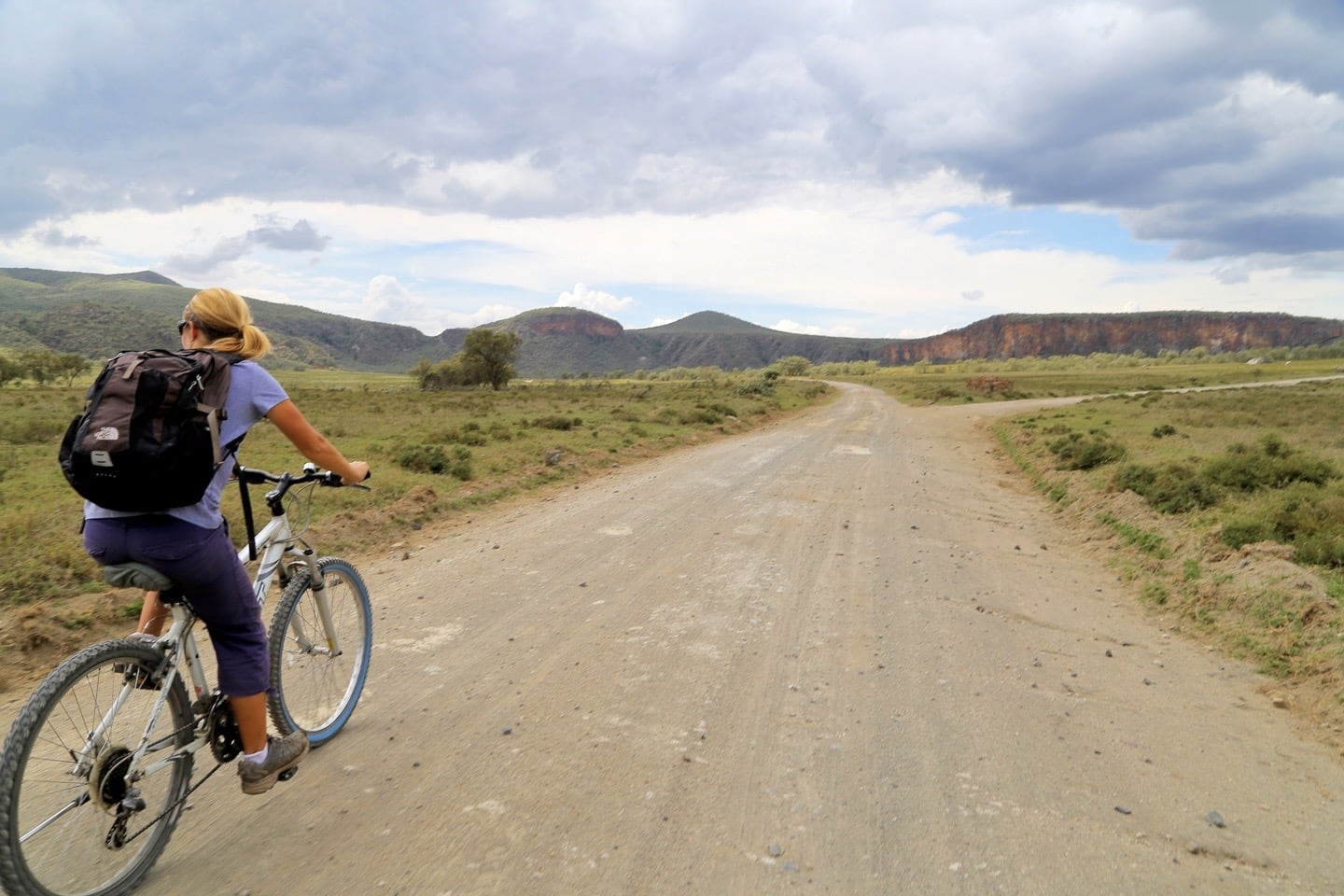
Lori and I loved our visit to this amazing place, which has been one of the surprise highlights of our travels in Kenya.
With the right information and some helpful first-hand tips, Hell’s Gate might just end up being one of your favorites as well!
Traveling in Kenya? Bookmark these guides:
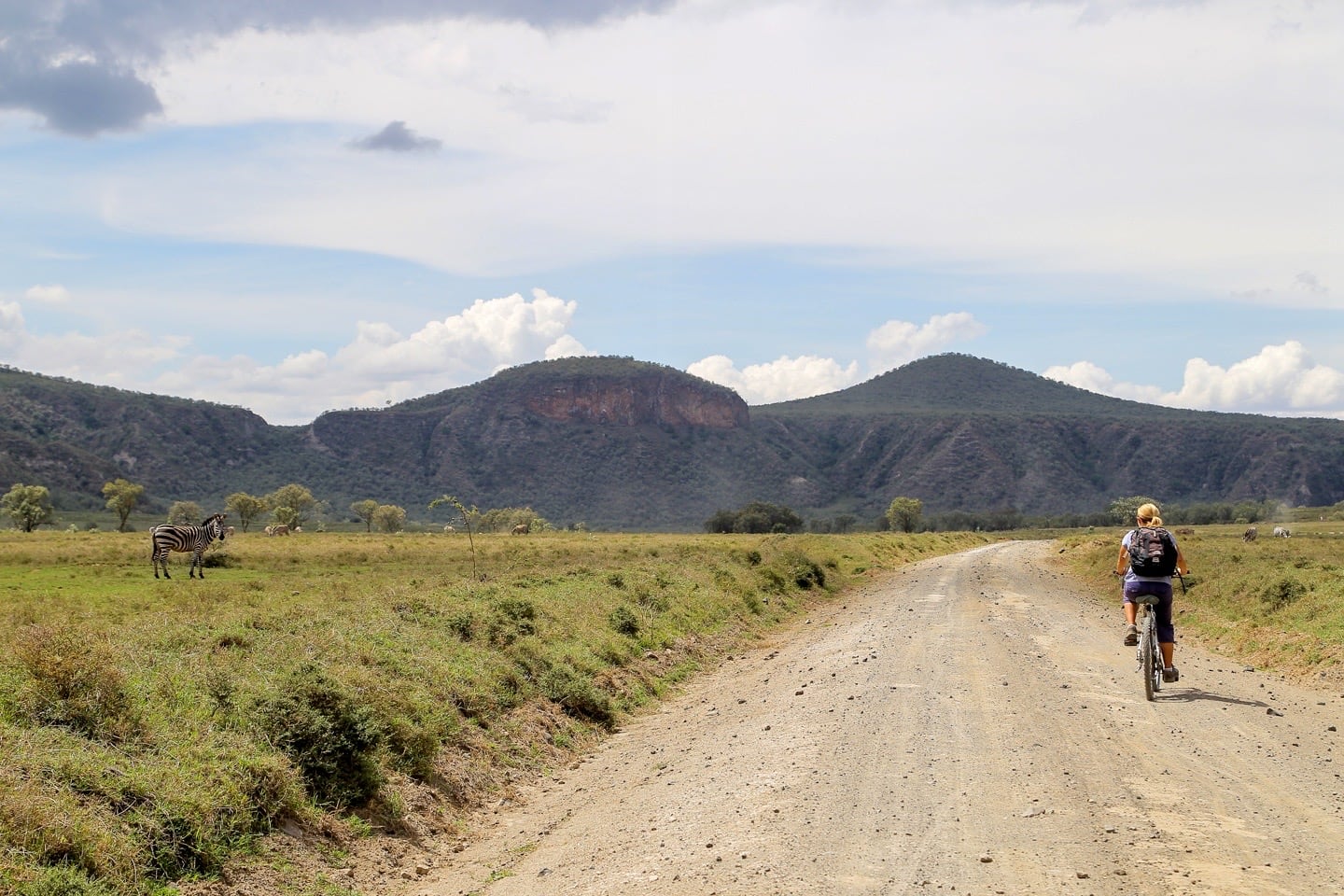
Why Visit Hell’s Gate National Park
When Lori and I first learned that there was a national park in Kenya you could RIDE YOUR BIKE THROUGH, we were sold. It was a once in a lifetime opportunity we couldn’t afford to pass up.
At only 68 square kilometers, Hell’s Gate is relatively small by Kenya standards, but one that packs a punch. It’s also one of the closest national parks to Nairobi, making Hell’s Gate an excellent safari option for travelers who have limited time or a tight budget.
The starkly beautiful Upper Gorge is home to a variety of wildlife and over a hundred species of birds. The alien landscape is characterized by sheer red rock cliffs and punctuated by spectacular rock towers and geothermal steam spewing from the underworld.
This dramatic backdrop inspired the background scenery of Disney’s The Lion King and also served as the setting for Tomb Raider: Cradle of Life.
Hells Gate National Park is also home to numerous free-roaming species of wildlife including baboons, zebra, hyena, African buffalo, giraffe, and even a handful of reclusive big cats (though they don’t generally pose a serious threat to visitors passing through).
Descending deeper into the Gates of Hell (i.e. Ol Njorowa or the Lower Gorge) offers a unique opportunity to explore a prehistoric tributary and scalding natural hot springs.
It is a truly unique and humbling experience to be able to ride through a park like this (free of the trappings of steel and glass surroundings) and one that we won’t soon forget.
There are several excellent options for Hells Gate National Park day trip tours from Nairobi. But if you’re on a shoestring budget or would rather travel in a more independent fashion, a DIY day trip to Hell’s Gate is worth your consideration.
Read on for our detailed first-hand guide to doing a day trip on your own to Hells Gate National Park from Nairobi and Lake Naivasha.
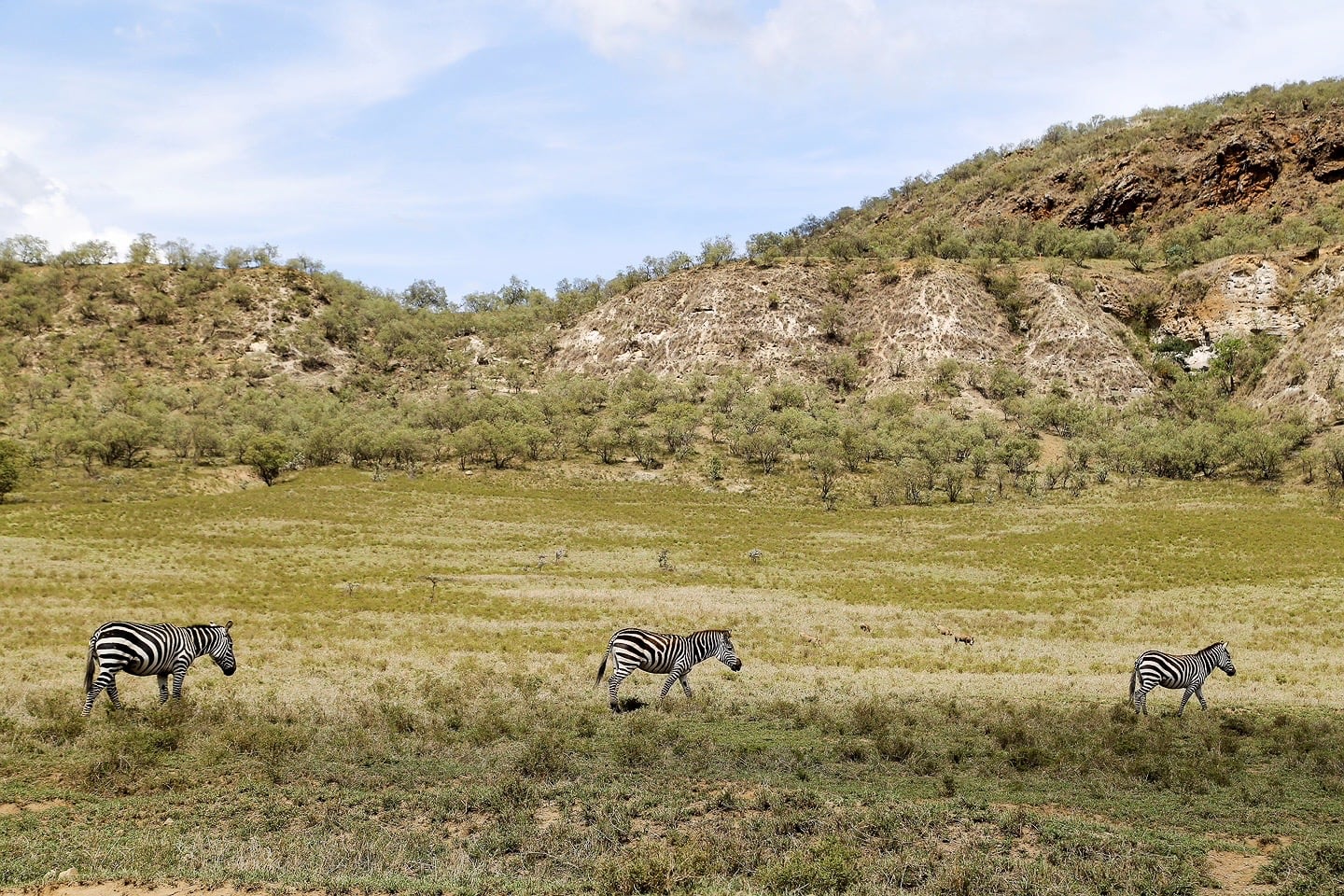
Our 2024 Tour Recommendations
If we were doing a day trip to Hells Gate National Park from Nairobi or Lake Naivasha right now, this would be our guided-tours short list.
Hell’s Gate & Naivasha Day Tours from Nairobi with Optional Boat Tour
Top Pick Private 9-hour day tour from Nairobi with Perfect Wilderness Tours⏤Experience Hells Gate National Park by bike and on foot with a knowledgeable and experienced guide.
Budget Pick 6-10 hour small group budget tour with African Beast Tours⏤If you’re on a budget but not keen on putting together the details yourself, this group tour might be what you’re looking for. This tour offers a similar itinerary to the two above, but with shared transport and guide (you’ll still get you’re own bike, of course!).
Multi-Day, Multi-Park Tours from Nairobi
5-day Maasai Mara, Lake Nakuru & Hell’s Gate small-group tour with Jocky Tours⏤For an incredible multi-day African adventure of a lifetime, check out this five-day (four night) safari for a chance to tour some of Kenya’s top national parks!
DIY Hells Gate National Park Tour
There are several excellent options for Hells Gate National Park day trip tours from Nairobi. But if you’re on a shoestring budget or would rather travel in a more independent fashion, a DIY day trip to Hell’s Gate is worth your consideration.
Read on for our detailed first-hand guide to doing a day trip on your own to Hells Gate National Park from Nairobi and Lake Naivasha.
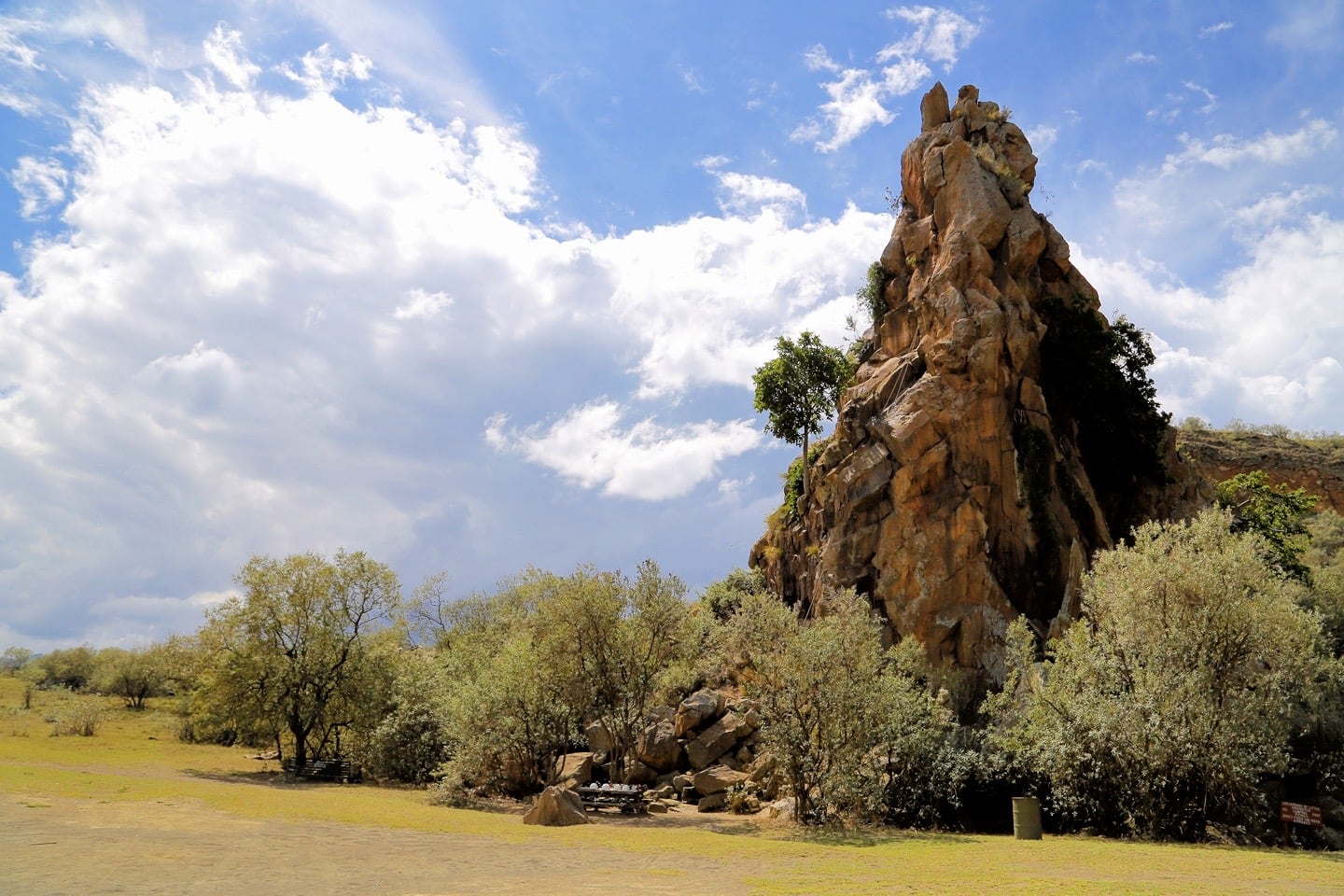
How to Get to Hells Gate National Park
If you’re pondering a day trip to Hells Gate National Park on your own, this guide and trip report will give you an idea of what you’re in for, plus helpful tips for putting it all together yourself.
Travelers opting to take public transport from Nairobi to Hell’s Gate will usually end up doing so in two legs using Matatus (collective van taxis).
Do keep in mind that public transport “schedules” in Kenya are flexible, Matatus leave when they fill up, and the journey may take longer than expected.
If you want to see the park and return to Nairobi in one day, you’re better off hiring a taxi through your hotel or guesthouse, or renting a car.
If you do find yourself getting “stuck” in the Naivasha area for the night, there are several excellent lodges and camps within a couple of kilometers of the park entrance.
Getting to Hell’s Gate (Nairobi to Naivasha)
If you plan to travel by public transport, you’ll need to take a Matatu from Nairobi to Naivasha Town, then another to the front gate of the park.
We caught the Navaisha/Nakuru Matatu at one of the Matatu stands on Latema Road. We were told by a friend to take the Mololine Express (near the old Odeon Cinema), as this offered non-stop service to Naivasha Town and Naivasha Junction.
It took us a bit of asking around once we got to Latema Road, but we did eventually find it (please let us know in the comments if the location has changed so we can update our guide).
We had an overall pleasant journey out to Naivasha Town and even managed to catch some pretty stunning views of the Rift Valley on our way.
Depending on how long it takes to leave the city (which can often feel like an eternity), expect the journey to Naivasha Town to take around 90 minutes self-driving and two hours by Matatu.
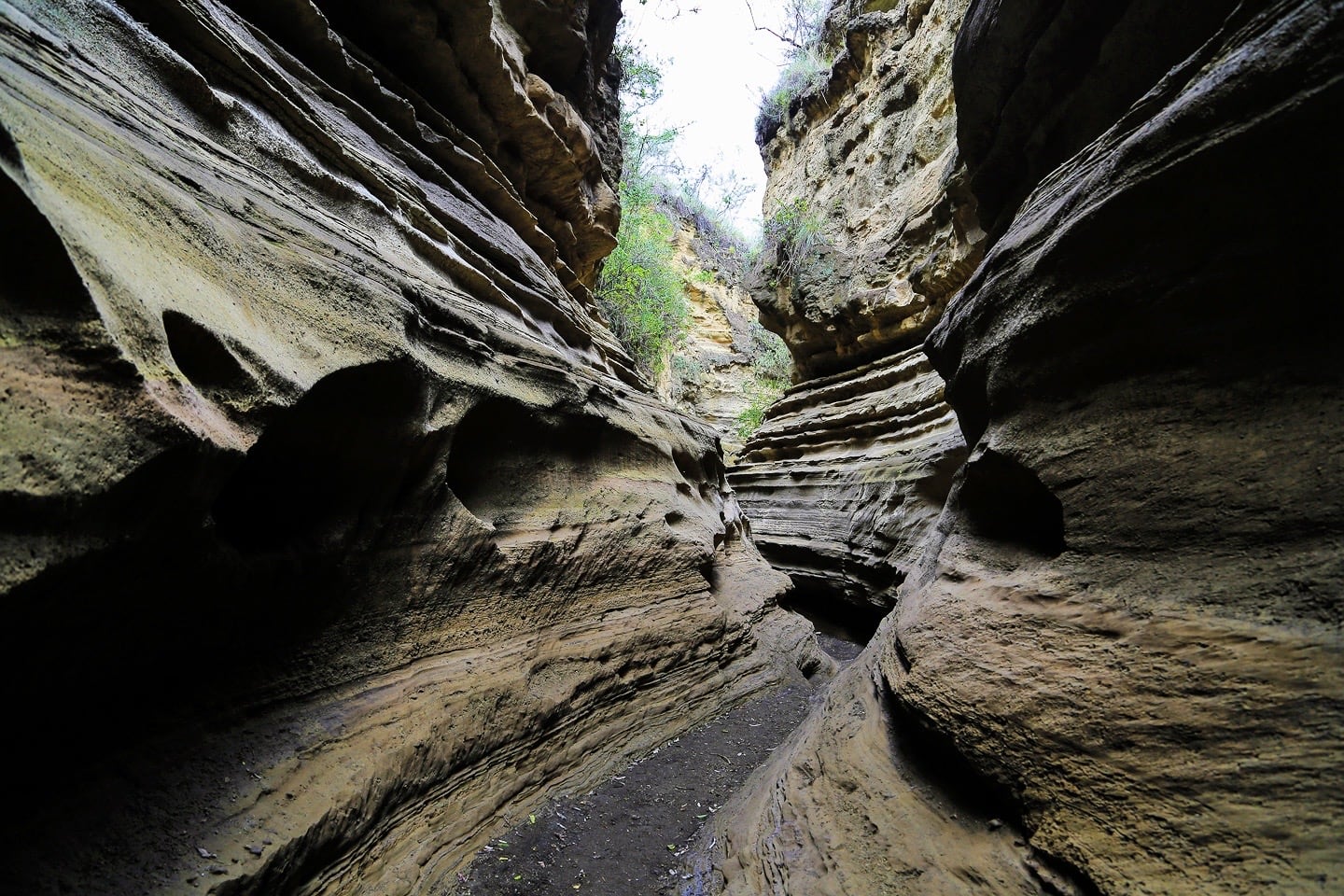
Getting to Hell’s Gate from Naivasha Town
The first leg should be pretty straightforward. How you choose to do this next leg will largely depend on whether you are attempting a day trip on your own or plan to stay at one of the lodges on Lake Naivasha (or one of the campgrounds in Hells Gate National Park).
If you’re self-driving or taking a taxi, you can head directly to the park entrance and parking lot. Parking (<6 seats) cost 300 KSh last we checked.
If you’re arriving in Naivasha by Matatu, you could ride the Matatu all the way into Naivasha Town and get off there.
But if you’re headed directly to Hell’s Gate or one of the fishing camps along the south shore, we recommend getting off at Naivasha Junction (junction with Moi South Lake Road) and catching a Matatu headed west.
Just let the driver or money collector know where you intend to get off (Hell’s Gate, Camp Carnelley’s, Fisherman’s Camp, etc.).
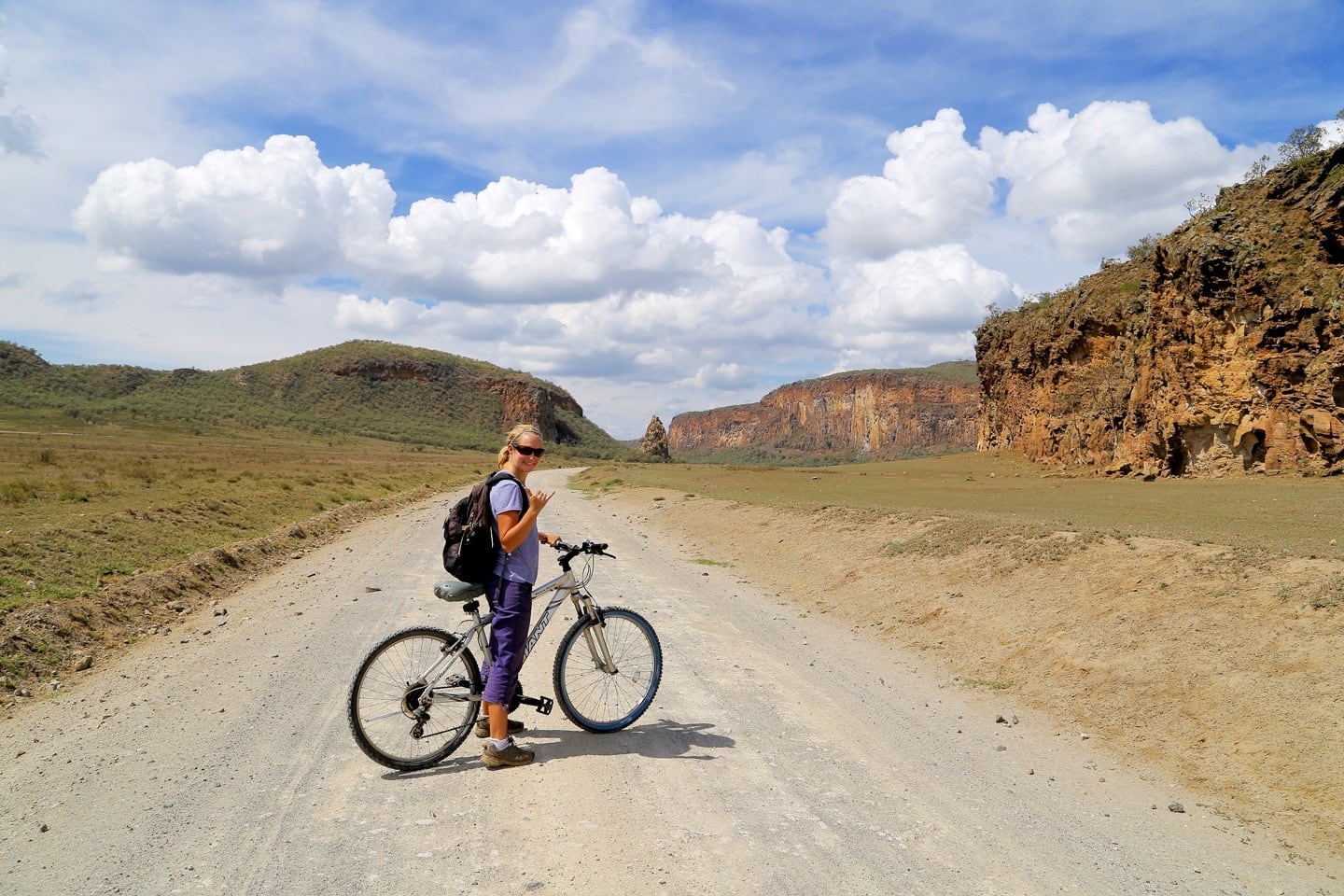
Biking Hell’s Gate National Park
Bicycling through the Upper Gorge of Hell’s Gate N.P. is the most common way of touring the park (bikes aren’t permitted in the Lower Gorge).
There are a number of places you can rent your bikes in and around Naivasha Town. The most convenient for many travelers might be to rent your bike at Elsa Gate (northeastern entrance to Hell’s Gate N.P.) for 1,000-2,000 KSh, but the bikes are not always in the best condition.
Most lodges and fishing camps in the area offer bike rentals, which might be a better bet and certainly more convenient if you are staying there.
We rented our bikes from Camp Carnelley’s (where we were staying) and were happy with the bikes. It’s of course always best to check out the bikes to make sure everything’s shipshape before you depart.
NOTE: You do not currently need a guide to bike around the main park (Upper Gorge). You will need a guide to descend into the Lower Gorge (more on that later).
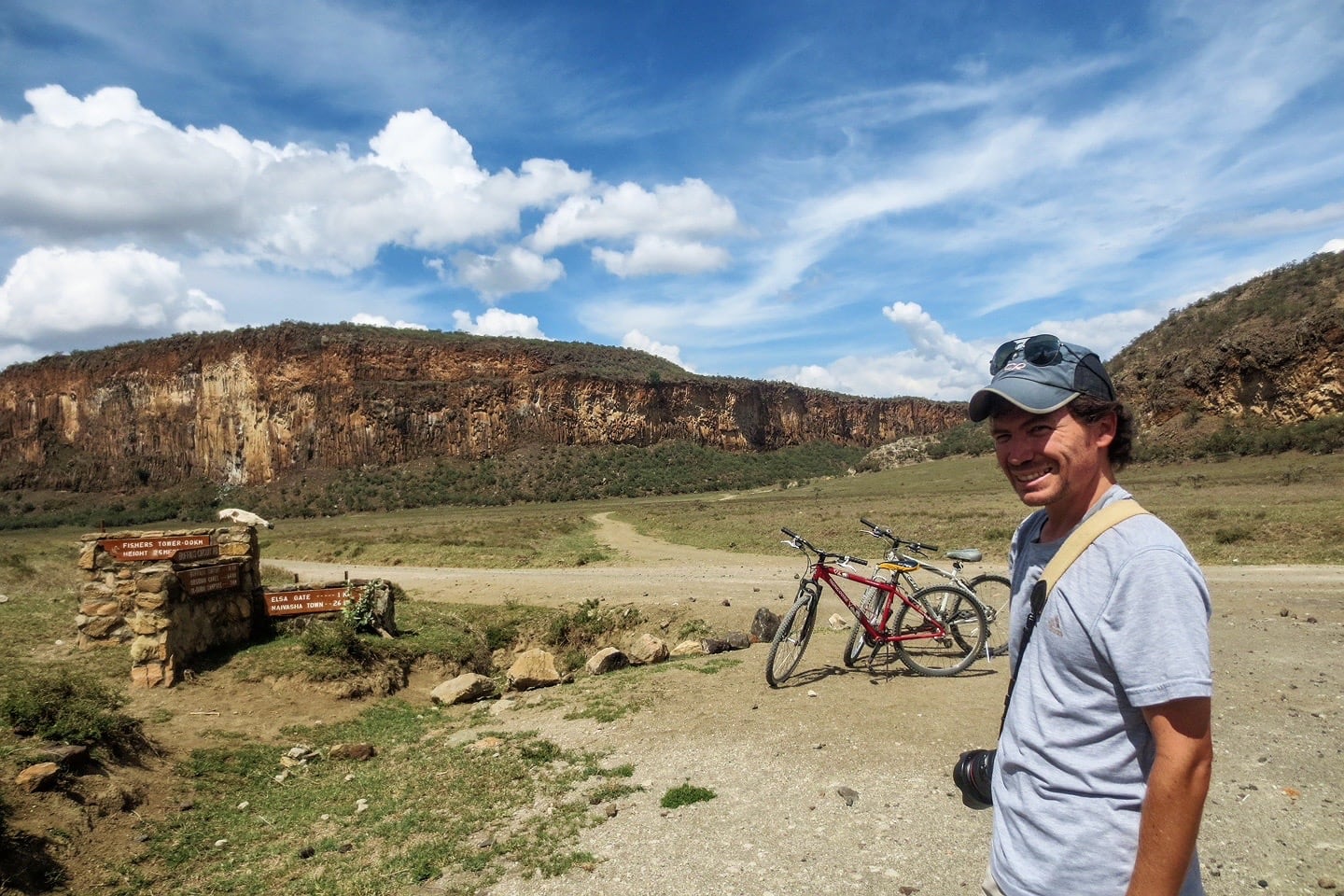
It took us about 30 minutes to ride the 6 km (~4 miles) of mostly gravel road from Camp Carnelley on Lake Naivasha to this point, via Elsa Gate. Despite being fairly warm and dusty, it was a pleasant ride.
Per the last published Kenya Parks fee sheet, the cost of entry to the park was US$30 (Jul-Feb) and US$20 (Mar-Jun) for non-resident adults.
In terms of biking the park, it’s a fairly relaxed ride on well-maintained dirt and gravel roads.
With that said, keep in mind that the roundtrip (return) distance from Elsa Gate to the Lower Gorge Ranger Post and back is 17 km (10.5 miles).
Also, the ride into the canyon has a gentle downward slope, while the ride out of the canyon, as you might expect, has a gradual incline.
🔥 HOT TIP 🔥
Be sure to plan accordingly for a long bike ride under African skies – cover up and pack an ample amount of water and snacks. If you’ve got padded bike shorts, your bum will thank you tenfold in the coming days!
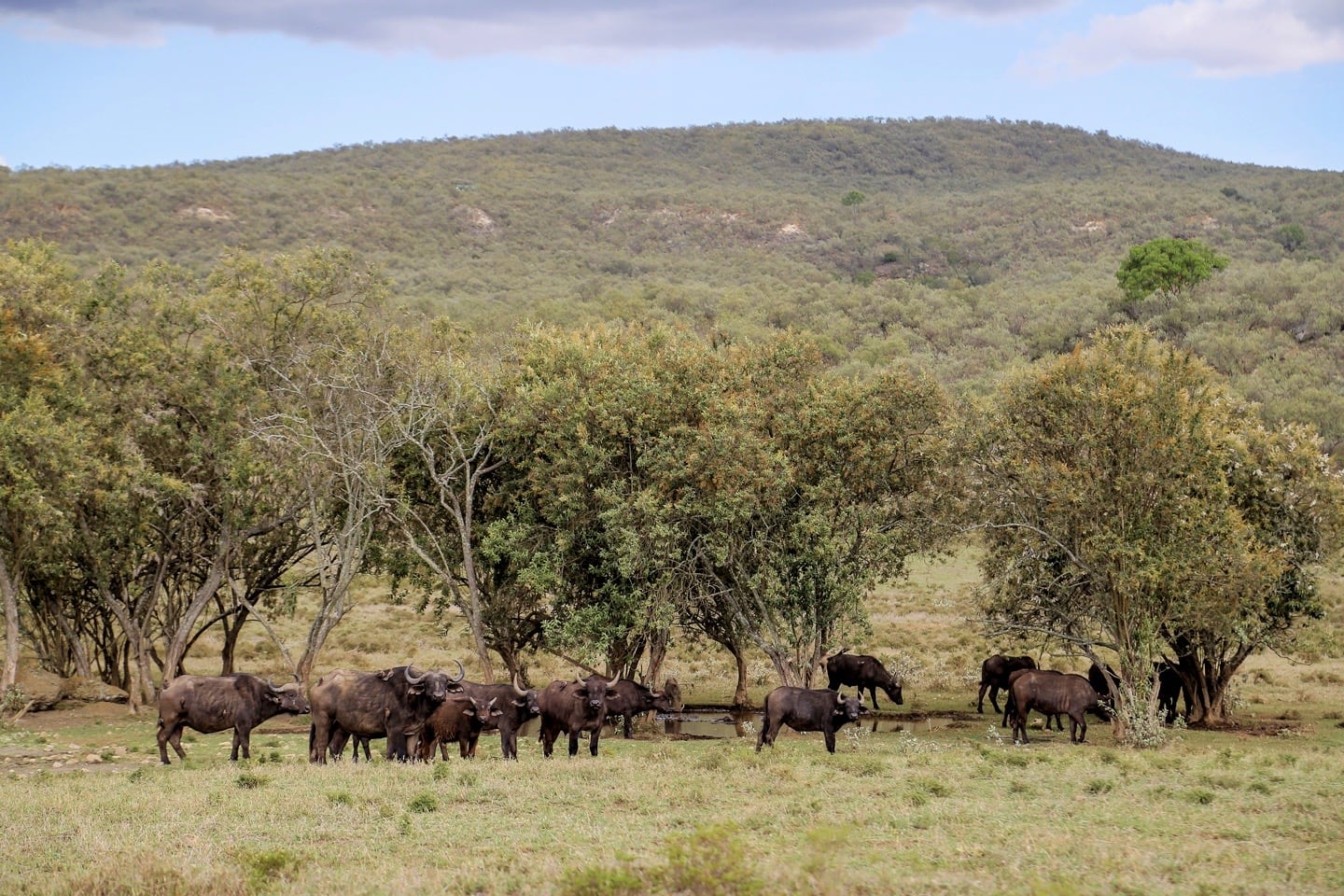
Hell’s Gate Wildlife
While the wildlife offerings here aren’t that unique from what you’ll see in other Kenyan parks, they were plenty to make our visit feel worthwhile.
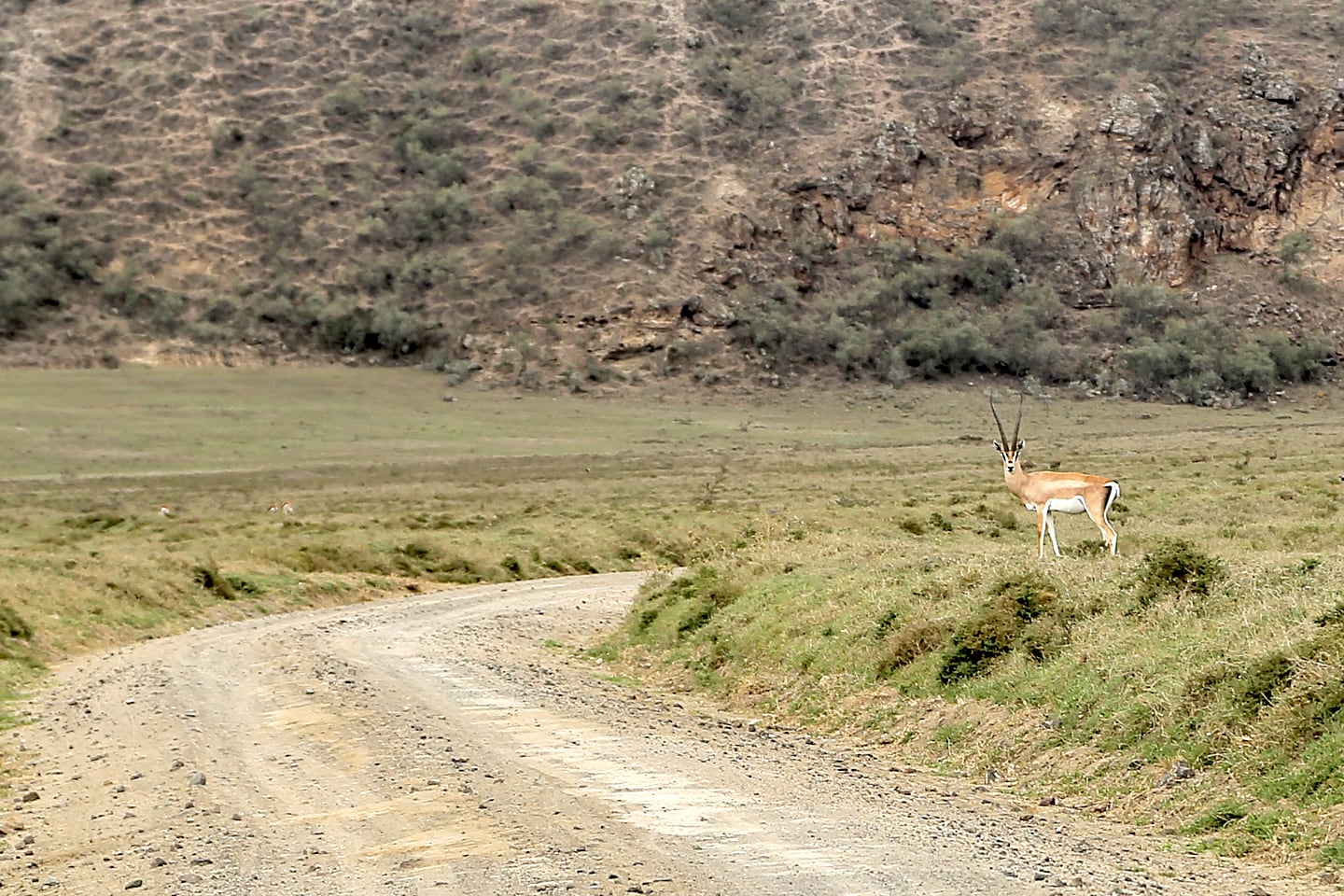
Along the way, we spotted African buffalo, zebra (so many zebra!), eland, warthogs, Thomson’s gazelle, vultures, buzzards, dassies, and a single giraffe, albeit quite far from us.
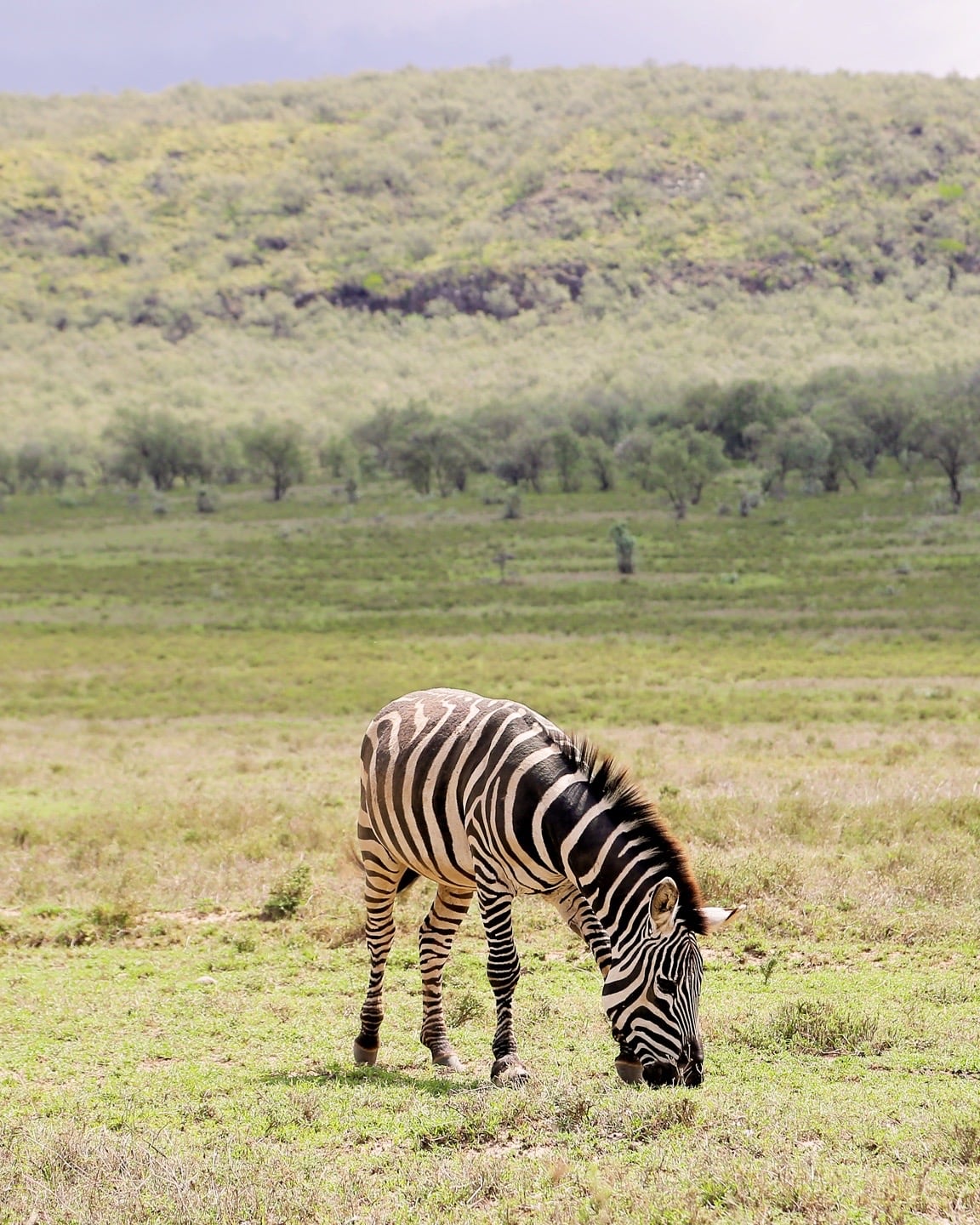
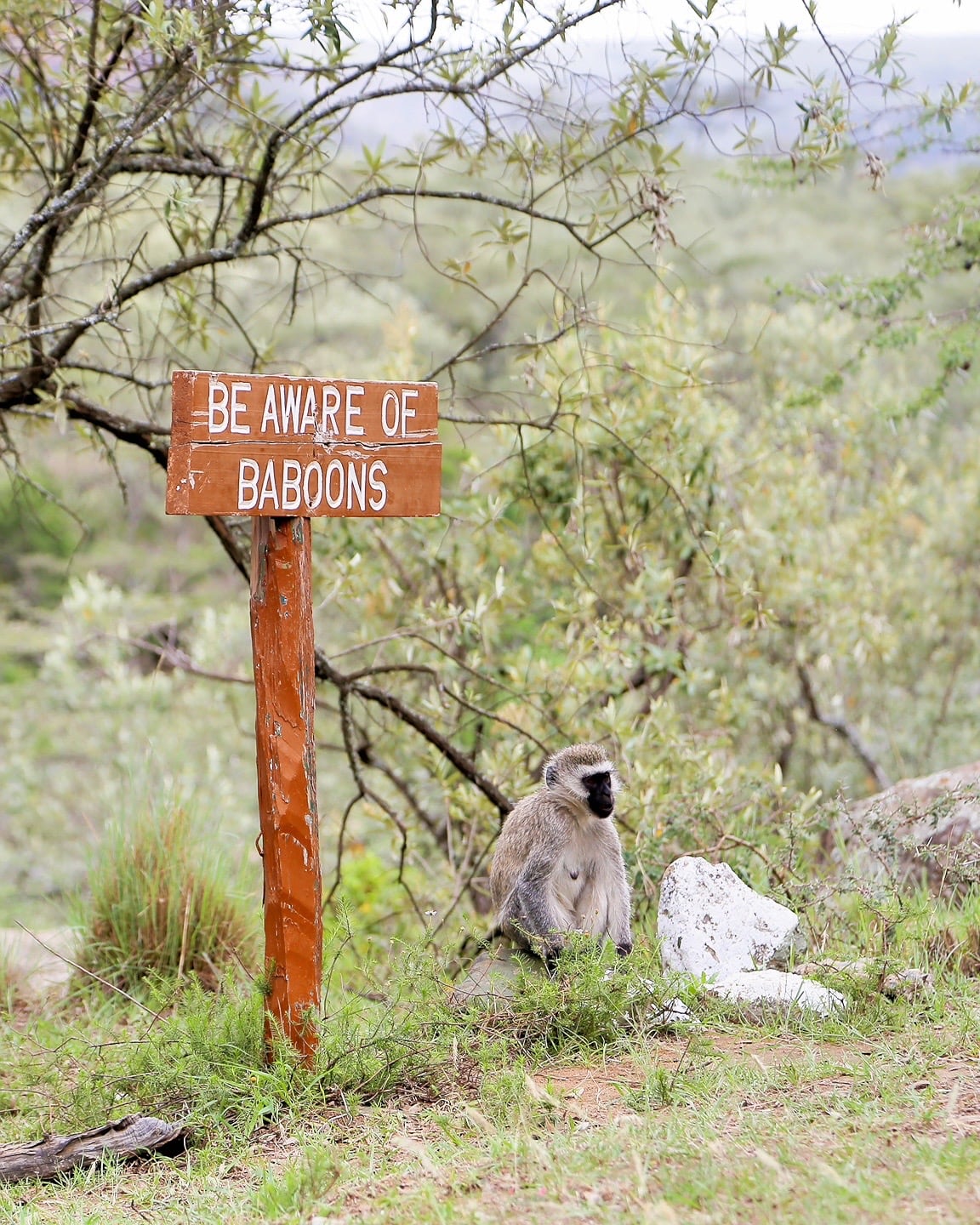
Around the entrance to the Lower Gorge, we saw quite a few baboons as well.
Additionally, we spotted numerous colorful and exotic birds that we can’t begin to identify and catalogue.
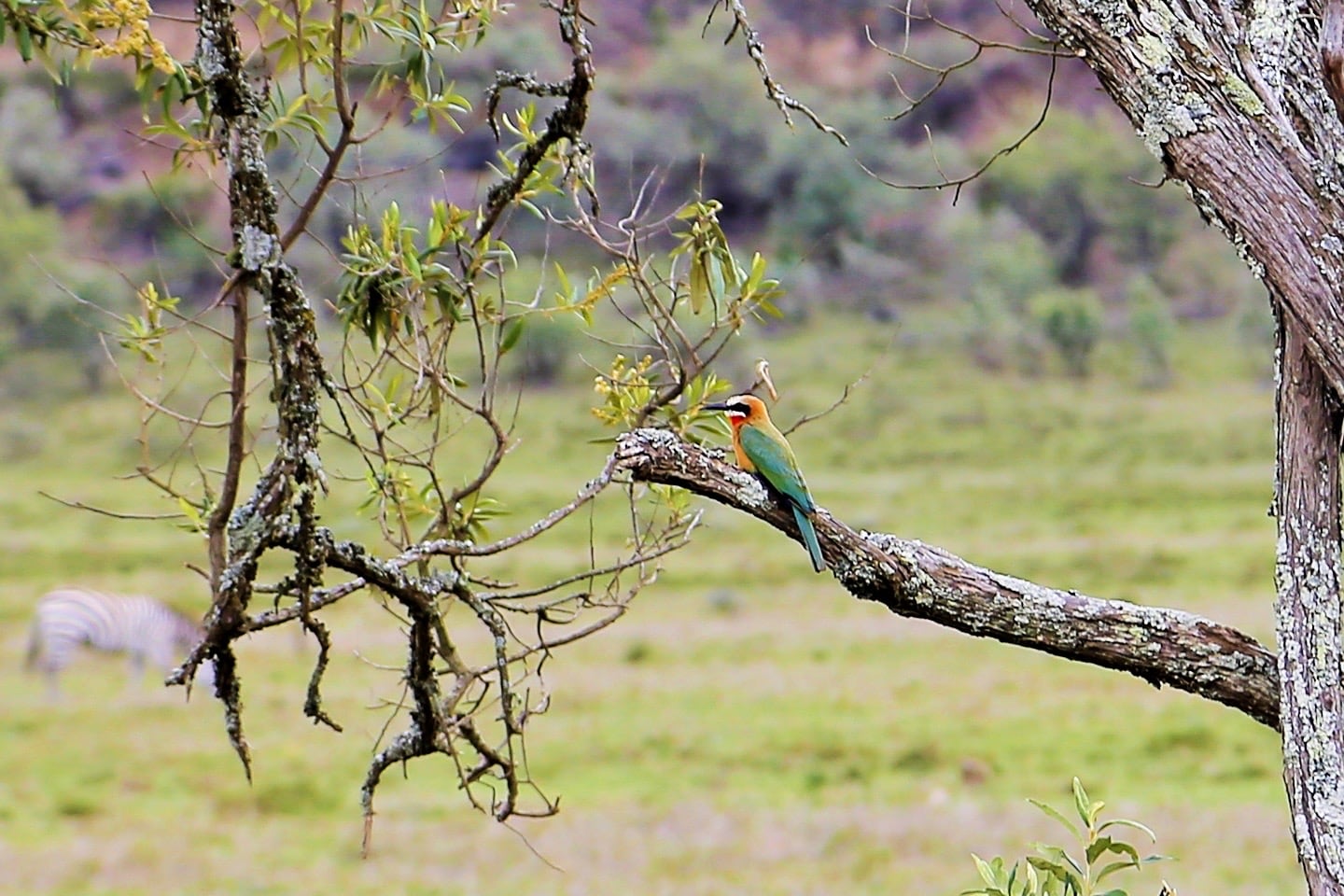
All in all, not a bad haul for a few hours in a relatively small park.
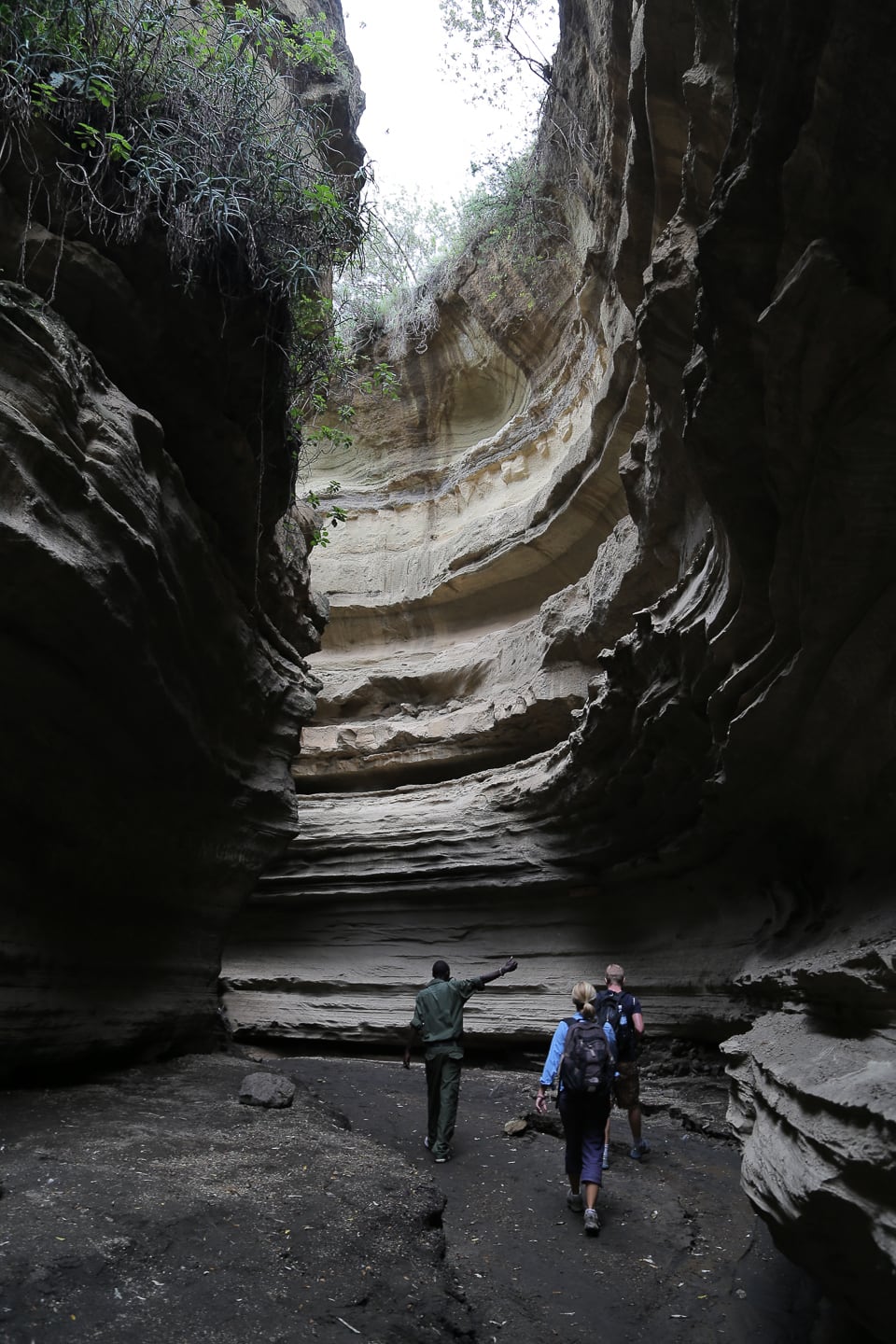
Hiking Ol Njorowa (Lower Gorge)
→ 2024 Lower Gorge Update ←
Ol Njorowa (Lower Gorge) has finally RE-OPENED to visitors following a five-year closure.
Ol Njorowa (Lower Gorge) is perhaps the most well-known section of Hell’s Gate, and for many, its biggest attraction.
The canyon’s stunning water-eroded walls reach to the sky, providing both large echoing spaces and narrow cuts just wide enough for a single person to pass in some places.
It is a spectacular sight to behold, but hiking the gorge also carries real risks. Flash floods have been known to fill the narrow passages at a moment’s notice, and an intimate knowledge of the gorge is a necessity for escaping. For this reason, hiking with a Park Ranger is critically important.
We had no problem finding a Ranger at the Ranger’s Post near the picnic area and entrance to the Lower Gorge. The cost of hiring a Ranger in Kenya National Parks was set at 1,720 KSh per guide last we checked (though this is subject to change).
We were able to split the Ranger’s fee with another traveler and ultimately found the knowledge and expertise of the Park Ranger to be indispensable as we made our way through the treacherous gorge.
After a quick lunch spent shooing baboons away from a small picnic shelter, we parked our bikes in a covered area near the Ranger’s Post and followed the Park Ranger into the depths of HELL (a.k.a. Ol Njorowa or the Lower Gorge).
Like Goldilocks, the Ranger presented us with three options for hiking: the short trail, a medium-sized “long trail,” and the much longer “very long trail.”
We opted for the medium option, which turned out to be just right.
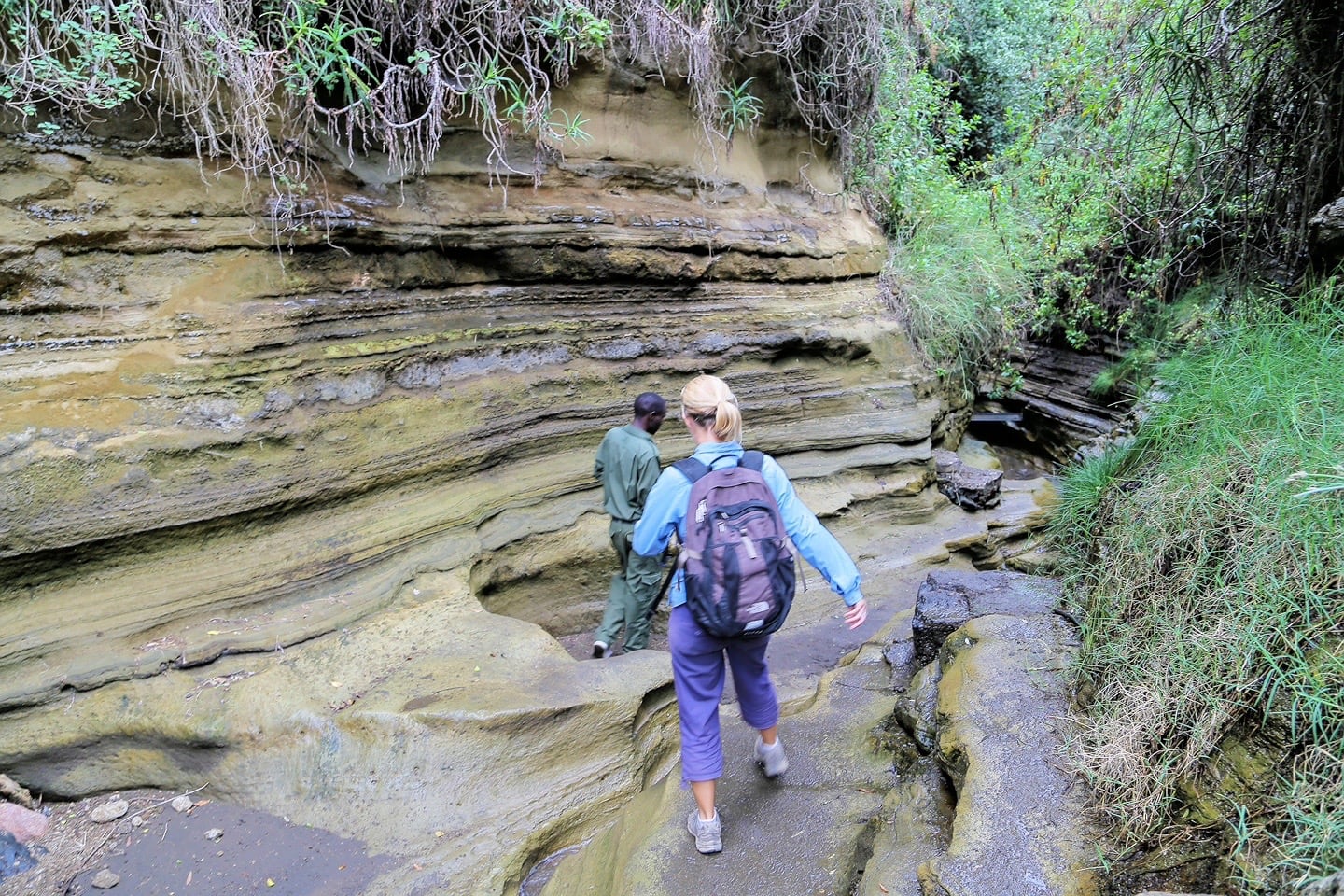
Lori and I were also warned that the hike can be quite steep and difficult, but didn’t find it too taxing. We also had the benefit of cloud cover on the day we visited, which kept the temperatures down, making for a very pleasant hike.
Yet, the dangers of hiking the Lower Gorge were never far from our minds. Flash flooding has been known to claim lives here, particularly in and around the two rainy seasons: April and May’s “long rains” and November’s “short rains,” though flash floods are possible throughout much of the year.
Our guide didn’t have us linger long in the depths of the canyon, and only had us continue on provided that the conditions remained dry. If a heavy rain were to start, we’d have a very narrow window of opportunity to vacate ahead of the rushing water.
It doesn’t happen often, but it does happen, and the huge logs jammed into various sections of the canyon (or suspended above) are testaments to that.
It remained dry, so we carried on.
Note: Six lives were lost in the Lower Gorge to flash flooding in 2019. The Lower Gorge was closed for nearly five years until safety concerns could be adequately addressed. As of September 2024, the Lower Gorge is now open.
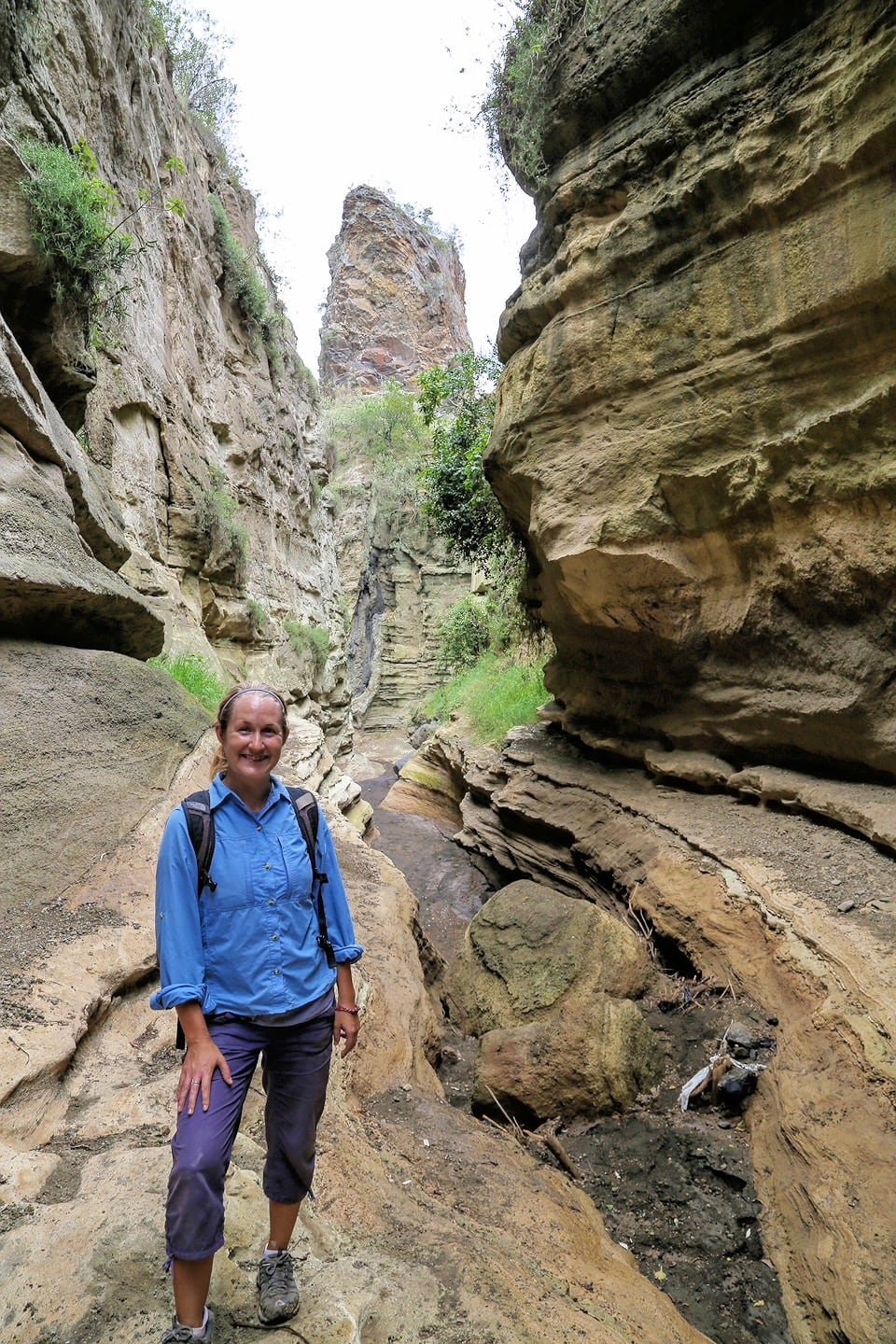
On a lighter note, we learned that Hell’s Gate N.P. has long served as the inspiration and setting for literature and films.
Perhaps most notable, the Upper gorge inspired the landscape of Disney’s The Lion King, while the Lower Gorge served as the setting for a key scene in Tomb Raider: Cradle of Life.
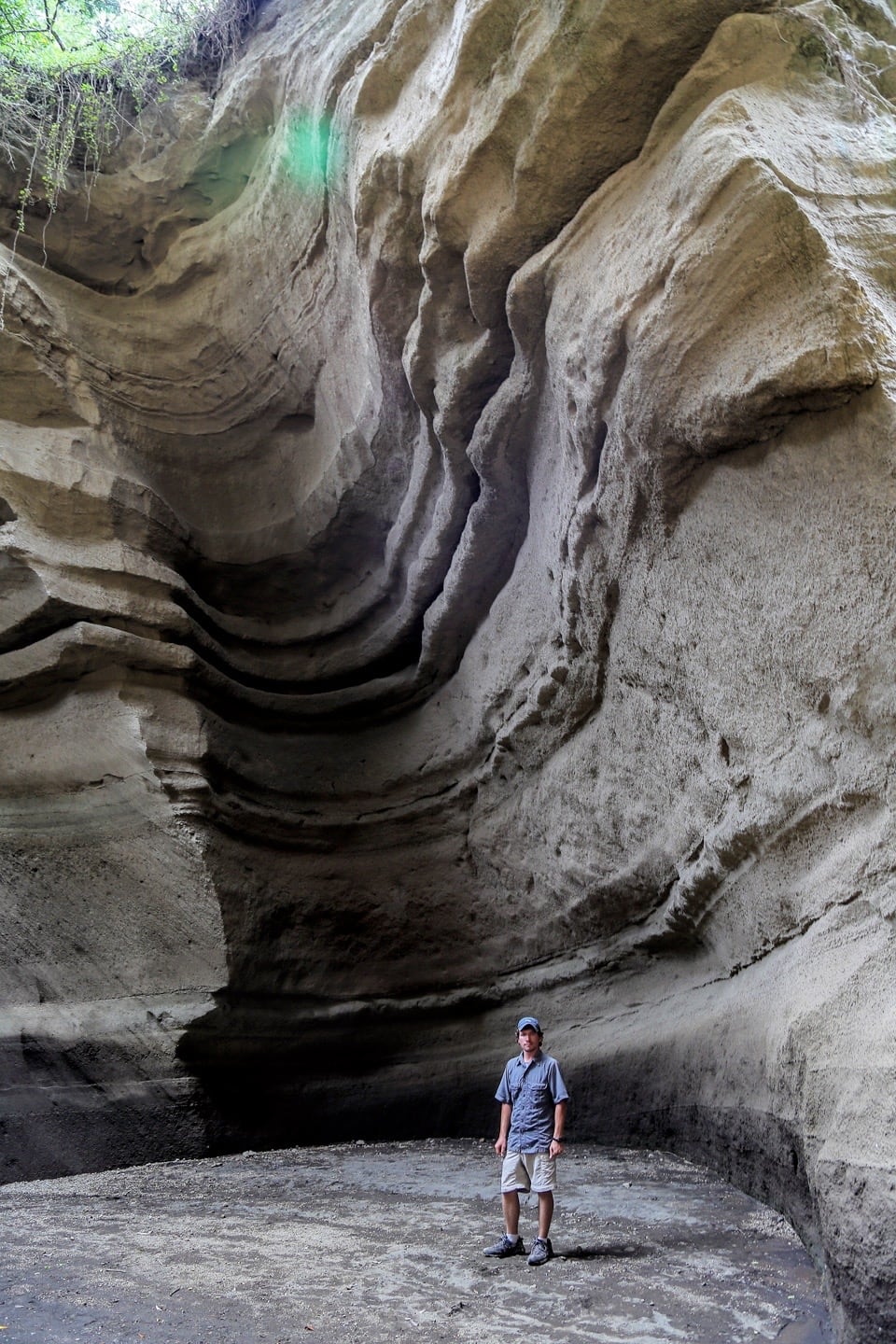
I was told that I’m standing in the “Devil’s Bedroom,” which appears prominently in the Tomb Raider movie. I haven’t seen the movie, but the formation is pretty amazing nonetheless.
Our guide was also quick to point out that the circular patterns in the “Bedroom” were carved from thousands of years of water rushing through here creating a whirlpool from which there is no escape.
On that sobering note, we turned around and quickly followed the Ranger out of the most harrowing portion of the gorge.
In not too long, we arrived at a bubbling spring flowing with steaming hot water.
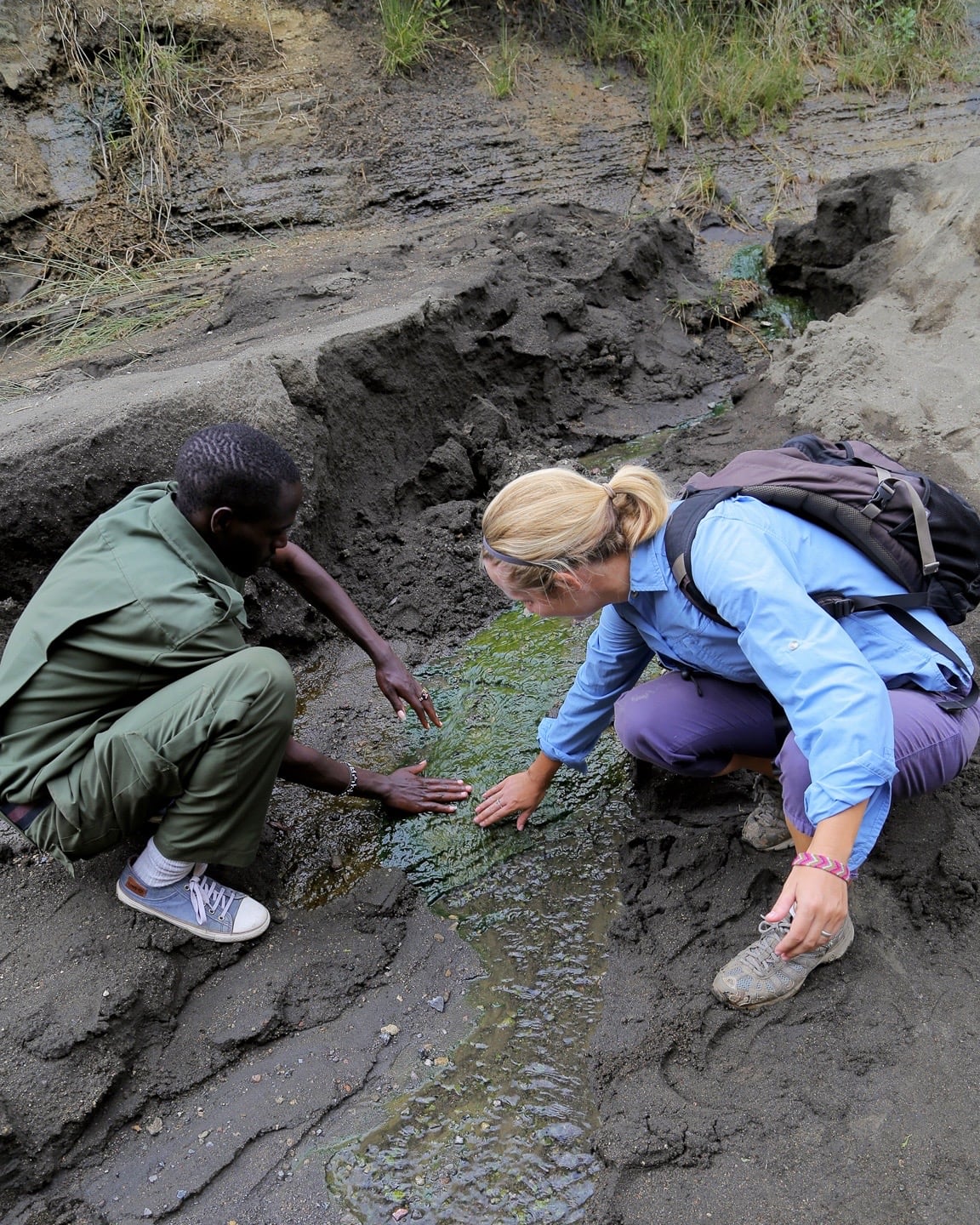
The Park Ranger ended the trek high up on a hill affording us a commanding view of the park and the awe-inspiring Rift Valley splayed out before us, in addition to a towering geothermal drill laboring away.
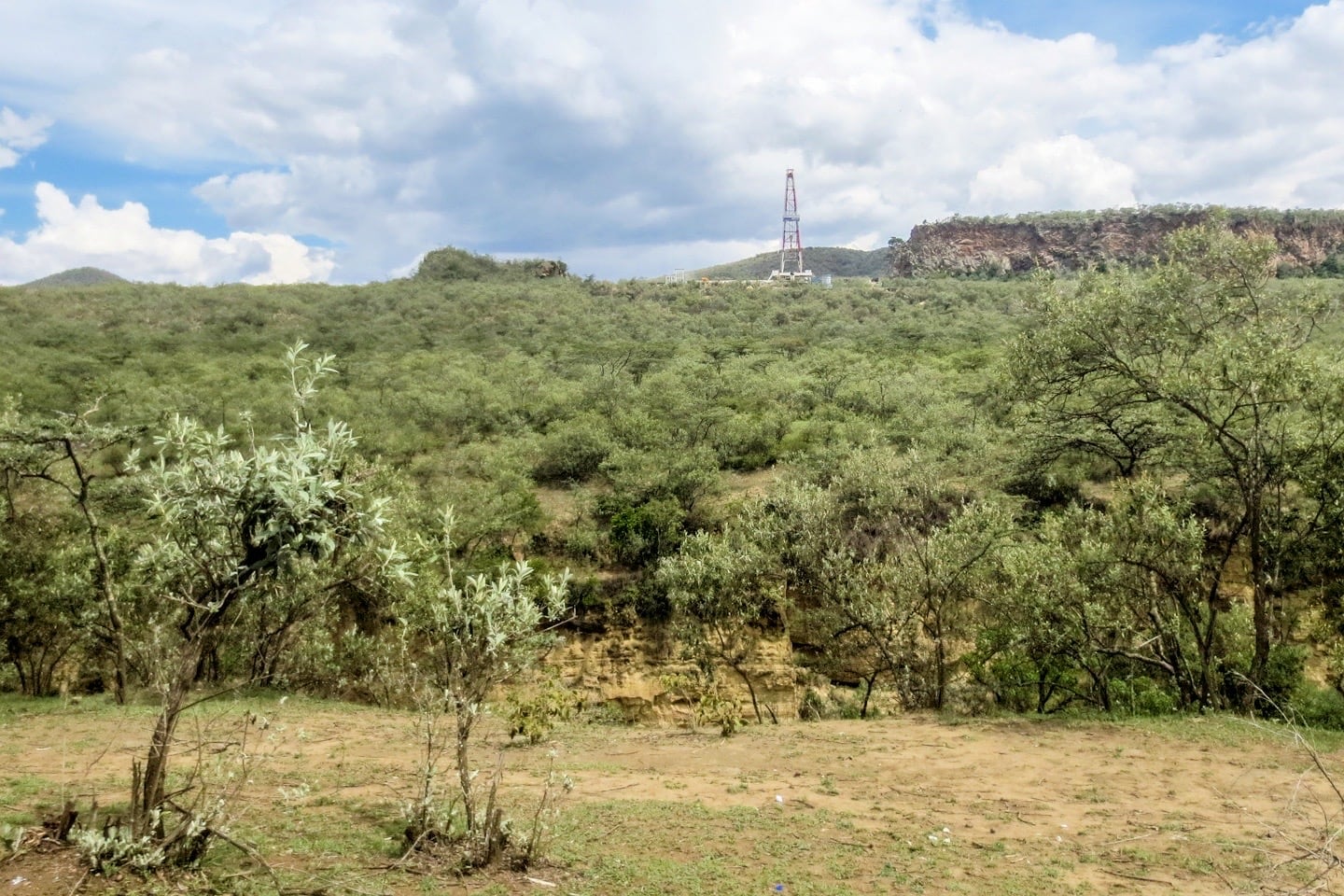
Hell’s Gate is home to a diversity of wild animals and a particularly stunning portion of the Rift Valley. But it also sits upon one of the country’s most significant sources of geothermal energy.
To date, this valley has become host to three geothermal power stations producing a combined 280 megawatts of power. That’s enough to provide electricity for 500,000 homes. And production is expected to be increased to a staggering 5,000 megawatts by 2030.
No doubt, the geothermal reserves below Hell’s Gate National Park hold great potential for meeting Kenya’s growing energy needs. Yet the heavy infrastructure required to harness the energy remains highly controversial, particularly with regards to Maasai land rights, wildlife habitat, and tourism impacts.
It remains to be seen what type of long-term effects this activity will have on all who inhabit and visit this amazing place.
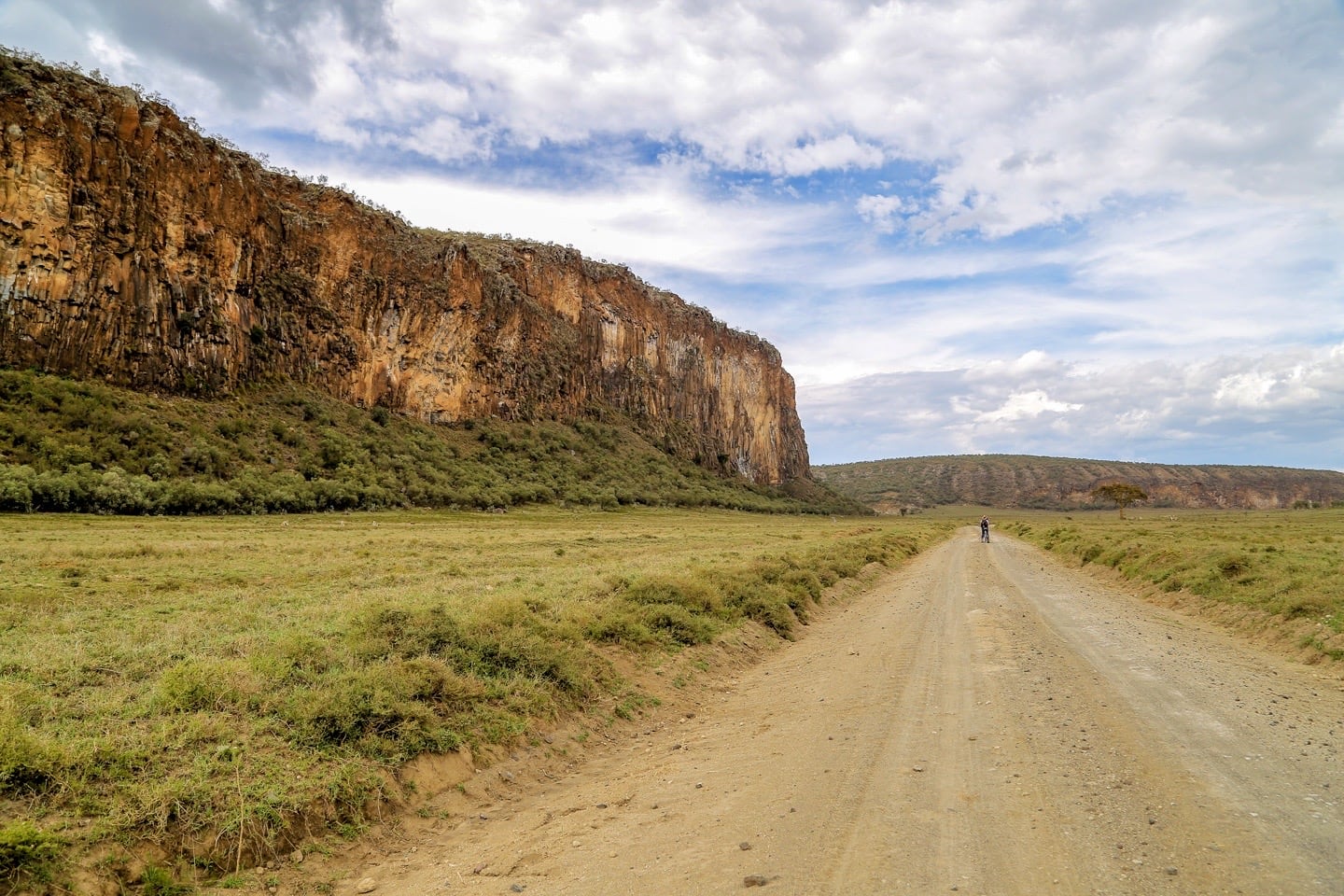
Final Thoughts
All in all, our independent day trip to Hell’s Gate National Park was a pretty memorable experience.
It was amazing to be able to stop riding when we wanted to in order to observe an African buffalo or zebra some distance away, or simply to listen to the silence all around us.
The vast majority of time there wasn’t another person in sight. At times it felt like we had this stunning place with all its wild inhabitants all to ourselves.
Whether you choose to explore Hells Gate National Park with a top tour company or on your own, we think that visiting this unique and wonderful corner of Kenya is certainly worth your consideration.
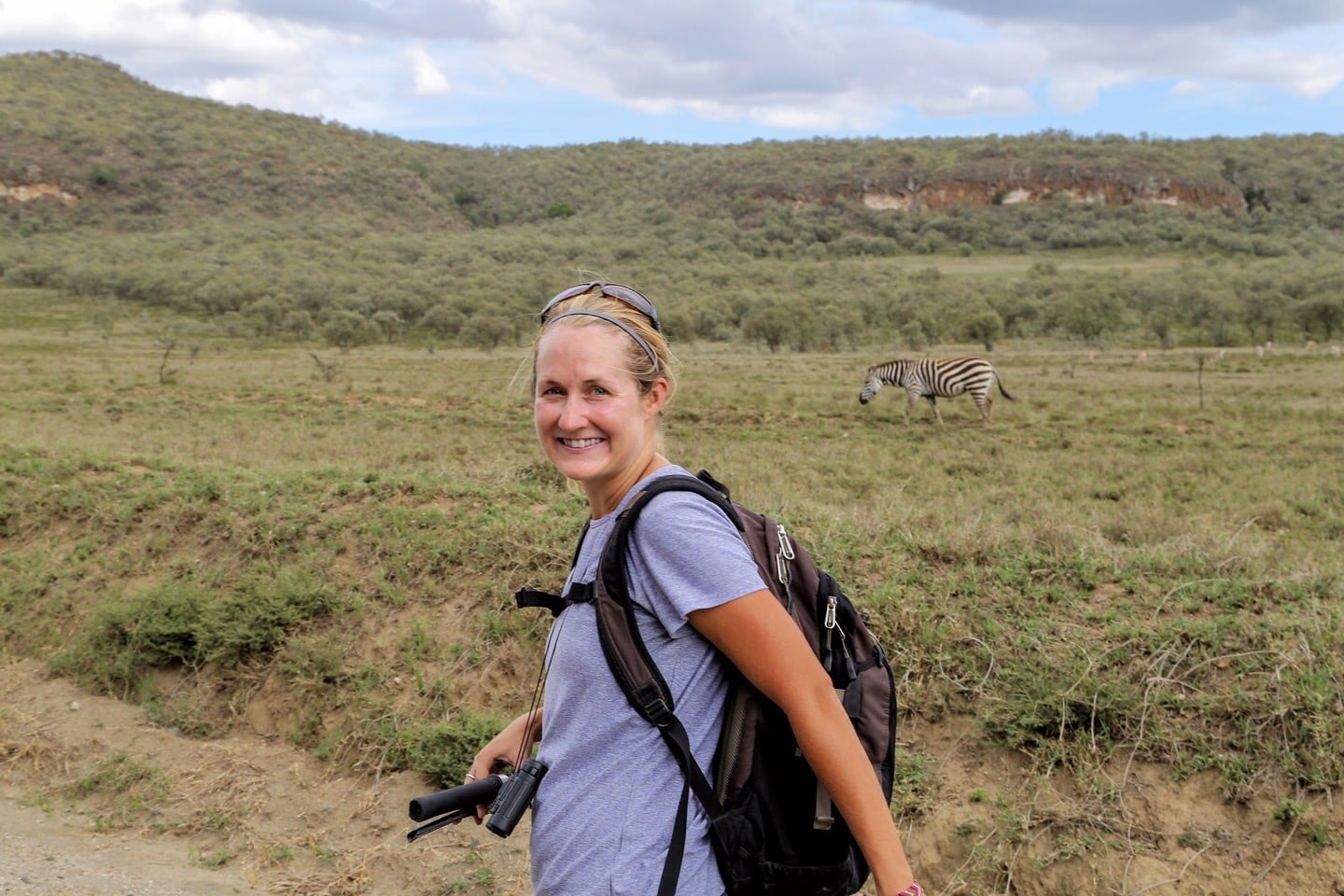
Thanks for this excellent guide! The info about the upper and lower gorges is useful.
Loved the information provided. Very useful
I found this super helpful – thank you so much!
Happy to here it!
Hillpeak School will be visiting on 9th august, 2023. Will give comment after the visit.
Thank you.
Hello there? I have gone through the information about Hells Gate National Park and I am delighted that I have found some of my pictures there.The guide in the pictures happens to be me though the picture was taken in 2014 but I still do the guiding tours.If the services were up to task I wouldn’t mind having another experience with the clients yet again.Its always amazing to do what I do.